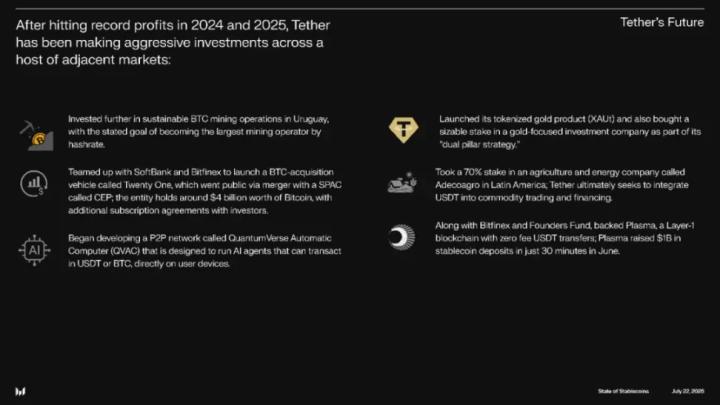Written by: Ethan
"2021 was the year of Layer 1 competition, and 2024 is the carnival of Meme. So, where will the market's main narrative go in 2025?"
This question that sparked heated discussion on X platform is being clearly revealed by mainstream capital: With the successful legislation of the GENIUS Act and stablecoins officially incorporated into the US sovereign regulatory framework, a new multi-dimensional financial narrative integrating "Stablecoins × RWA × ETF × DeFi" is rising forcefully.
In this profound evolution of cross-chain finance, the core focus is no longer Bitcoin or Meme coins, but the struggle between Ethereum and Solana's old and new orders. The two public chains have essential differences in technical architecture, compliance strategies, expansion paths, ecosystem construction models, and even value foundations.
Currently, this competition that will determine the future landscape has entered a critical stage where capital is making fierce bets with real money.
Capital Betting Preference: From "BTC Faith" to "Choose Between ETH/SOL"
Unlike previous crypto bull markets driven by macro currency with uniform rises and falls, the 2025 market shows clear structural differentiation. Head projects are no longer rising in sync, and funds are concentrating bets on selected battlefields, with a trend of survival of the fittest.
The most direct signal comes from changes in institutional buying strategies:
On the ETH front: Multiple US listed companies are beginning to establish large-scale Ethereum asset vaults.
On July 22, GameSquare announced adjusting its digital asset vault authorization to $250 million and adding 8,351 ETH, with a clear goal of "configuring high-quality Ethereum ecosystem assets and achieving stablecoin returns";
SharpLink Gaming has cumulatively added 19,084 ETH this month, with a total position of 340,000 ETH, market value exceeding $1.2 billion;
A new wallet address bought over 106,000 ETH through FalconX in the past 4 days, worth nearly $4 billion;
The Ether Machine announced completing a backdoor listing with 400,000 ETH and obtaining over $1.5 billion in financing support from top institutions including ConsenSys co-founder, Pantera, and Kraken, aiming to become the "largest public ETH output company".
On the SOL front: Purchase scale is equally astonishing and more speculatively explosive.
Listed company DeFi Development Corp announced adding 141,383 SOL, with total holdings approaching 1 million;
SOL treasury company Upexi announced buying 100,000 SOL for $17.7 million, with total holdings of 1.82 million, already with over $58 million in floating profits;
According to CoinGecko data, PENGU has reached a market cap of $2.785 billion, surpassing BONK ($2.701 billion), becoming the largest market cap Solana ecosystem Meme coin.
These phenomena indicate that ETH and SOL have become the primary underlying assets for institutional multi-asset allocation. However, their investment logics show significant differences: ETH is used as a "chain-based government bond + high-quality asset underlying + spot ETF eligible institutional target"; SOL is being crafted into a "high-performance consumer application chain + new Meme economy's main battlefield".
These two betting methods respectively represent expectations for two main lines of the crypto market's future: ETH is the institutionally-taken-over financial engine, SOL is the speculative track for capital's offensive bet.
[The translation continues in the same manner for the rest of the text, maintaining the specified translation rules.]As BTC stabilizes at $120,000, ETH approaches $4,000, and SOL returns above $200, high volatility accompanies high enthusiasm, which is a prelude to new narratives and major fund repositioning. What we see is not speculative frenzy, but an increasingly shorter feedback loop between "on-chain behavior and price reaction".
This is a model driven by consumption data to trade expectations, which ETH cannot achieve, but SOL has become the paradigm.
Whale Game and Policy Catalysis: Who Can Absorb the Funds' Repositioning Bullets?
Technical applications determine a public chain's "narrative potential", while funds and policies determine its "trading capacity" - especially after BTC breaks $120,000 and the market enters the main upward wave, identifying the next stage's "fund convergence area" is crucial.
On-chain data shows that since Q2 2025, three institutions' "on-chain positioning" behaviors have shown completely different strategies: Grayscale continuously increased ETH holdings from May to July (cumulative 172,000, about $640 million), clearly used for its spot ETH ETF base position construction; Jump Trading has frequently rebalanced on Solana since June, focusing on BONK, PENGU, and Jupiter, and accumulated nearly 280,000 SOL through multiple addresses; DeFi Development Corp and Upexi, two listed companies, have continuously announced SOL increases, forming over a million Token holdings (total market value near $500 million) and achieving significant floating profits.
This is not a simple "win-lose" bet, but market stratification: ETH is a "structural asset allocation", SOL is a "short-cycle volatility tool".
Policy wind direction differentially boosts "dual-line growth". On July 19, US President Trump formally signed the GENIUS Act, with the first US stablecoin federal regulatory framework landing, coupled with Coinbase and BlackRock submitting S-1 spot ETH ETF files, making the "ETH inclusion in compliance framework" path increasingly clear. Meanwhile, Solana team collaborates with exchanges like OKX and Bybit to promote "consumer asset compliant issuance" experiments. For example, OKX launched a Solana chain asset exclusive Launchpad in July and introduced a light KYC mechanism for MEME coin issuance.
This "dual compliance" means policy dividends are being distributed differentially based on application scenarios, fund attributes, and risk preferences: ETH continues to absorb traditional capital, while SOL becomes a compliant experimental field for young users and consumption scenarios.
Short-term policy expectations: ETH benefits more obviously, SOL faces fewer restrictions. Although ETH is at the policy dividend forefront in ETF and RWA aspects, it also faces multiple SEC thresholds in securities attribute determination and staking classification. SOL ecosystem, with less involvement in centralized issuance and complex staking channels, makes its Tokens and applications easier to enter the regulatory "gray safety zone". This leads to ETH's growth path being more stable but longer-cycled, while SOL's growth path is steeper and more volatile.
Who Defines the Future? Hedging Allocation, Not Binary Choice
From the market path after BTC breaking $120,000, the difference between ETH and SOL is no longer a linear question of "who replaces whom", but a distributed answer of "who defines the future in what cycle".
ETH is the Medium-to-Long-Term Narrative Protagonist under Structural Support
Under the GENIUS Act, ETH's path to financial compliance is clear. Whether pushing spot ETF or positioning as a "clearing layer" in RWA models, it becomes Wall Street's "core asset" for blockchain asset allocation.
From institutional positioning logic of BlackRock, Fidelity, etc., ETH is evolving from "Gas Token" to "basic financial platform", with valuation anchors shifting from on-chain activity to Treasury yield models and Staking rates. ETH's victory is not through explosion, but through sedimentation.
SOL is a Short-Term Detonator in Structural Cracks
Contrary to ETH's stability, SOL becomes the main battlefield for fund gaming in high-frequency trading, MEME coin narratives, terminal applications, and native consumer goods (like Saga phone). From BONK to PENGU, to JUP's governance experiment, Solana chain has built a high-liquidity, high-penetration "native narrative market".
Combining on-chain actual performance: SOL's TPS, cost, and terminal response speed continuously lead; SVM ecosystem's independence also helps it escape EVM ecosystem's internal competition and redundant construction.
More importantly, SOL is one of the few "capable and willing to bear funds with high volatility" narrative low points, becoming a core short-cycle option for capturing "rapid fund rotation response" after BTC launches the main upward wave.
Therefore, this is not a "selection question", but a "cycle game question":
For mid-to-long-term funds optimistic about institutional changes and traditional capital's structured entry, ETH is the first choice. For short-cycle participants hoping to capture fund rotation and narrative explosion opportunities, SOL provides more tension-filled Beta exposure.
Between narrative and system, volatility and sedimentation, ETH and SOL may no longer be opposing options, but constitute the optimal combination under a time mismatch.
Who defines the future? Currently, the answer might not be a single project, but a continuous fine-tuning process of this "combination weight".







